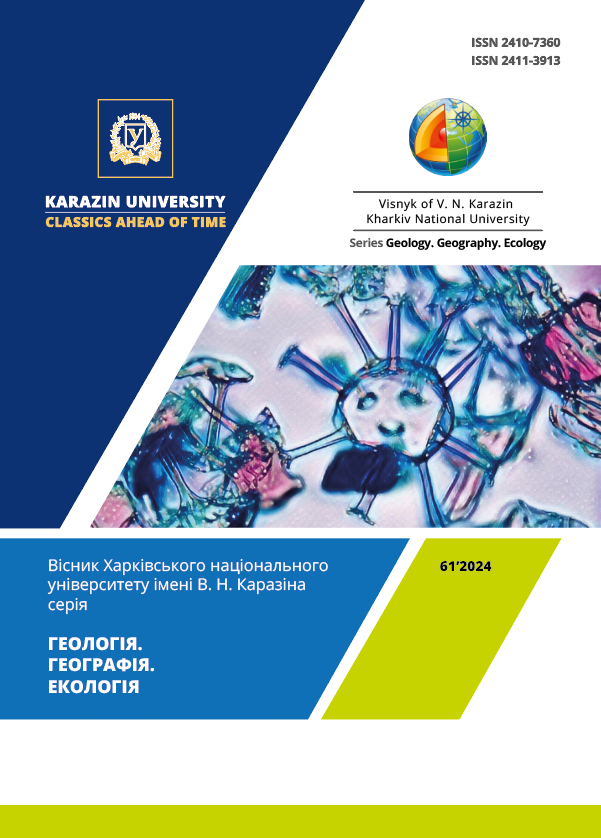Cartographic and analytical assessment of land price formation depending on the physical and geographical conditions of the territory under military aggression in Ukraine
Abstract
Background. The presented study sheds light on the issue of land price formation in Ukraine as a result of military aggression in conditions of uncertainty. The research involved identifying the peculiarities of the formation of the real price of land plots in the case of concluding a purchase and sale agreement in conditions of uncertainty, depending on a complex of price-forming factors, primarily, taking into account the distance from the line of combat with intensive combat operations, geographical conditions of the territory. It has been shown that the land market under wartime conditions is effectively in a state of stagnation due to numerous risks for both sellers and buyers. The lack of clear legal regulation and the high risk of property loss lead to land purchase and sale transactions being carried out with significant restrictions, which do not meet the criteria for the full functioning of a market mechanism.
Methods. Used research methods: geospatial data analysis (kriging method), mathematical statistics, cartographic-analytical assessment. Among the main types of uncertainty, several determining factors are identified: political and military risks, instability of the legal environment, potential losses, uncertainty of the reliability (sufficient security) of the geographical location of land plots, as well as the uncertainty of the future.
Results. The sale price of land plots for various purposes exhibits dynamic and geospatial differentiation, depending on the manifestation of various determining factors: the state of the military-political and economic situation, as well as their geographical location, which generally corresponds with soil quality. It is characterized by the location of land plots within urban agglomerations of large settlements and/or under the protection of natural obstacles, such as rugged terrain or large bodies of water (lakes, rivers), which can potentially slow down a military offensive.
Conclusions. A significant influence of the remoteness of land plots for the maintenance of a residential building and farm buildings from a localized combat zone (in the period 2014-2022) was revealed, however, the distance of land plots from the combat line at a distance of 50 to 100 km had practically no effect on the formation of the purchase price - the sale of land plots, which is connected with the intensification of hostilities and the transition of the situation to a state of higher degree of uncertainty. The obtained results provide important information for planning the future development of the land market under wartime conditions and post-war recovery. They indicate the need to adapt land valuation methods considering the current military-political realities and are aimed at minimizing risks for participants in land relations. The results of the study indicate the need to make appropriate changes in the methodology of normative monetary valuation of land plots and the methodology of expert monetary valuation of land plots.
Downloads
References
About expert monetary valuation of land plots. Postanova dated October 11, 2002 N 1531 Kyiv. Verkhovna Rada of Ukraine https://zakon.rada.gov.ua/laws/show/1531-2002-%D0%BF#Text [in Ukrainian].
Al-Adhami, A., & Abu-Shah, M. (2014). The Impact of the Civil War in Libya on Real Estate Prices.Real Estate Market Journal, 61-63.
Allouche, В., Kreindler, J. (2018). The Impact of the Syrian Conflict on Land Prices in Urban Areas.
Berk, C. (2018). The Impact of War on the Real Estate Market in Yemen: An Empirical Analysis. Land Economics, 4-10.
Elbersen, B., Beaufoy, G., Jones, G., Noij, I., van Doorn, A., Breman, B., &Hazeu. (2020). GIS-based assessment of land degradation due to military operations: A case study of XYZ conflict zone. 4-16.
Fedirko, A., Khoma, R., & Reznichenko, D. (2022). A study of the real estate market during the war Ernst & Young. Forbes.ua https://forbes.ua/money/budivnitstva-ne-zapuskayutsya-popitu-nemae-ale-tsini-ne-padayut-doslidzhennya-rinku-nerukhomosti-pid-chas-viyni-vid-ernst-amp-young-13032023-12337 [in Ukrainian].
Food and Agriculture Organization of the United Nations. (2024). World Reference Base for Soil Resources. FAO Soils Portal https://www.fao.org/soils-portal/data-hub/soil-classification/world-reference%20base/en:contentReference[oaicite:0]{index=0}
Geoinformation system of management of community land resources. (2022). Magnetic One Municipal Technologies: https://magneticonemt.com/geoinformatsijna-systema-upravlinnya-zemelnym-bankom-gromady [in Ukrainian].
Guangsheng, Z., Hongmei, L., Yingxuan, W., Biao, C., Zongliang Z. (2016). The impact of rural out-migration on arable land use intensity: Evidence from mountain areas in Guangdong, China. ScienceDirect, 569-579.
John, A. G., & Marland, M. (2019).The Impact of War and Insecurity on Land Prices in Kabul, Afghanistan.
Ma, Y., Lyu, D., Sun, K., Li, S., Zhu, B., Zhao, R., & Zheng, M. (2019). Application of GIS for assessing land damage caused by military activities in conflict zones. EconomicLiga.
Monitoring of land relations. (2023). State Service of Ukraine for geodesy, cartography and cadastre: https://land.gov.ua/monitorynh-zemelnykh-vidnosyn [in Ukrainian].
Norton, C., Dannenberg, M., Yan, D., Wallace, C., Rodriguez, J., Munson, S., Smith, W. (2017). Utilizing GIS and remote sensing techniques for assessing land cover changes in conflict-affected areas, 8-17.
Region of Ukraine guide (2019). State Statistics Service of Ukraine: https://ukrstat.gov.ua/druk/publicat/kat_u/2019/zb/12/zb_ru1ch2019.pdf [in Ukrainian].
Santangelo, Grazia (2018). The impact of FDI in land in agriculture in developing countries on host country food security. Journal of World Business, 53, 75–84. https://doi.org/10.1016/j.jwb.2017.07.006
Shypulin, V. (2010). The main principle of geoinformation systems. Kharkiv: Kharkivsʹka natsionalʹna akademiya misʹkoho hospodarstva [in Ukrainian].
Stefanski, J., Chaskovskyy, O., & Waske, B. (2014). Mapping and monitoring of land use changes in post-Soviet western Ukraine using remote sensing data. Appl. Geogr, 154-168. https://doi.org/10.1016/j.apgeog.2014.08.003
The public cadastral map (2021). Kadastr Live https://kadastr.live/#6.8/49.615/33.445 [in Ukrainian].
Thompson, S. (2017). The Real Estate Market in Conflict Zones.Journal of Real Estate Research.
Transparent land use: questions and answers (29.11.2022). Transparentcities https://transparentcities.in.ua/articles/prozore-zemlekorystuvannia-zapytannia-ta-vidpovidi- [in Ukrainian].

This work is licensed under a Creative Commons Attribution 4.0 International License.





